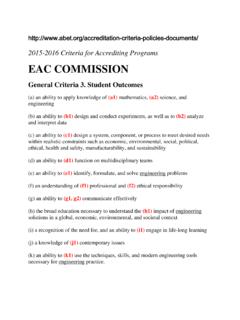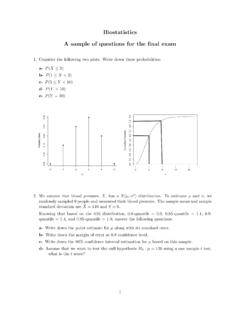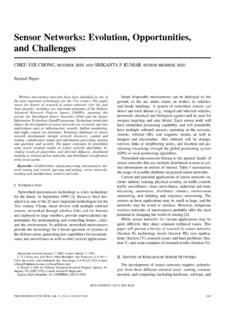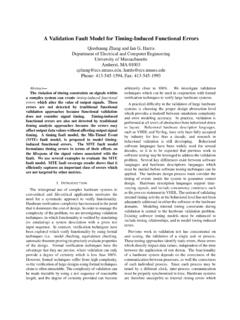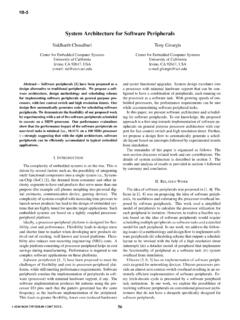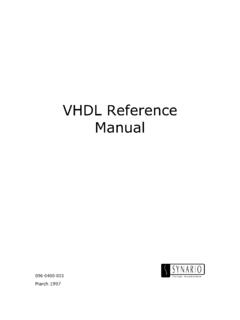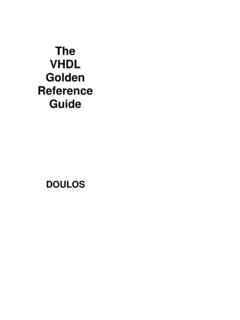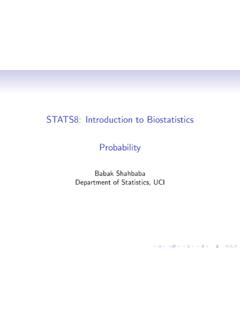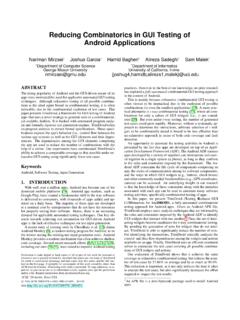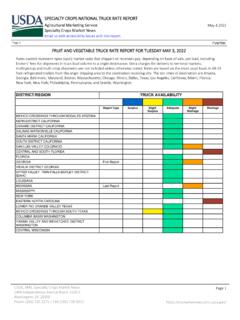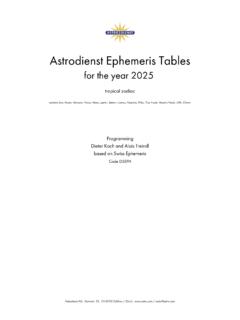Transcription of UNIVERSITY OF CALIFORNIA, IRVINE DISSERTATION …
1 UNIVERSITY OF CALIFORNIA, IRVINE . Architectural Styles and the Design of Network-based Software Architectures DISSERTATION . submitted in partial satisfaction of the requirements for the degree of DOCTOR OF PHILOSOPHY. in Information and Computer Science by Roy Thomas Fielding DISSERTATION Committee: Professor Richard N. Taylor, Chair Professor Mark S. Ackerman Professor David S. Rosenblum 2000 . Roy Thomas Fielding, 2000 . All rights reserved. The DISSERTATION of Roy Thomas Fielding is approved and is acceptable in quality and form for publication on microfilm: _____. _____. _____. Committee Chair UNIVERSITY of California, IRVINE 2000 . ii DEDICATION. To my parents, Pete and Kathleen Fielding, who made all of this possible, for their endless encouragement and patience. And also to Tim Berners-Lee, for making the World Wide Web an open, collaborative project.
2 What is life? It is the flash of a firefly in the night. It is the breath of a buffalo in the wintertime. It is the little shadow which runs across the grass and loses itself in the sunset. Crowfoot's last words (1890), Blackfoot warrior and orator. Almost everybody feels at peace with nature: listening to the ocean waves against the shore, by a still lake, in a field of grass, on a windblown heath. One day, when we have learned the timeless way again, we shall feel the same about our towns, and we shall feel as much at peace in them, as we do today walking by the ocean, or stretched out in the long grass of a meadow. Christopher Alexander, The Timeless Way of Building (1979). iii TABLE OF CONTENTS. Page LIST OF FIGURES ..vi LIST OF TABLES ..vii ACKNOWLEDGMENTS ..viii CURRICULUM VITAE ..x ABSTRACT OF THE DISSERTATION ..xvi INTRODUCTION.
3 1. CHAPTER 1: Software Architecture ..5. Run-time Configurations ..12. Properties ..12. Patterns and Pattern Languages ..16. Views ..17. Related Work ..18. CHAPTER 2: Network-based Application Evaluating the Design of Application Architectures ..26. Architectural Properties of Key Interest ..28. iv CHAPTER 3: Network-based Architectural Styles ..38. Classification Methodology ..38. Data-flow Styles ..41. Replication Styles ..43. Hierarchical Styles ..45. Mobile Code Peer-to-Peer Limitations ..59. Related Work ..60. CHAPTER 4: Designing the Web Architecture: Problems and Insights ..66. WWW Application Domain Requirements ..66. Problem ..71. CHAPTER 5: Representational State Transfer (REST)..76. Deriving REST ..76. REST Architectural REST Architectural Views ..97. Related Work ..103. CHAPTER 6: Experience and Evaluation ..107. Standardizing the REST Applied to REST Applied to Technology Architectural Lessons.
4 138. v LIST OF FIGURES. Page Figure 5-1. Null Style 77. Figure 5-2. Client-Server 78. Figure 5-3. Client-Stateless-Server 78. Figure 5-4. Client-Cache-Stateless-Server 80. Figure 5-5. Early WWW Architecture Diagram 81. Figure 5-6. Uniform-Client-Cache-Stateless-Server 82. Figure 5-7. Uniform-Layered-Client-Cache-Stateless-S erver 83. Figure 5-8. REST 84. Figure 5-9. REST Derivation by Style Constraints 85. Figure 5-10. Process View of a REST-based Architecture 98. vi LIST OF TABLES. Page Table 3-1. Evaluation of Data-flow Styles for Network-based Hypermedia 41. Table 3-2. Evaluation of Replication Styles for Network-based Hypermedia 43. Table 3-3. Evaluation of Hierarchical Styles for Network-based Hypermedia 45. Table 3-4. Evaluation of Mobile Code Styles for Network-based Hypermedia 51. Table 3-5. Evaluation of Peer-to-Peer Styles for Network-based Hypermedia 55.
5 Table 3-6. Evaluation Summary 65. Table 5-1. REST Data Elements 88. Table 5-2. REST Connectors 93. Table 5-3. REST Components 96. vii ACKNOWLEDGMENTS. It has been a great pleasure working with the faculty, staff, and students at the UNIVERSITY of California, IRVINE , during my tenure as a doctoral student. This work would never have been possible if it were not for the freedom I was given to pursue my own research interests, thanks in large part to the kindness and considerable mentoring provided by Dick Taylor, my long-time advisor and committee chair. Mark Ackerman also deserves a great deal of thanks, for it was his class on distributed information services in 1993 that introduced me to the Web developer community and led to all of the design work described in this DISSERTATION . Likewise, it was David Rosenblum's work on Internet-scale software architectures that convinced me to think of my own research in terms of architecture, rather than simply hypermedia or application-layer protocol design.
6 The Web's architectural style was developed iteratively over a six year period, but primarily during the first six months of 1995. It has been influenced by countless discussions with researchers at UCI, staff at the World Wide Web Consortium (W3C), and engineers within the HTTP and URI working groups of the Internet Engineering Taskforce (IETF). I would particularly like to thank Tim Berners-Lee, Henrik Frystyk Nielsen, Dan Connolly, Dave Raggett, Rohit Khare, Jim Whitehead, Larry Masinter, and Dan LaLiberte for many thoughtful conversations regarding the nature and goals of the WWW architecture. I'd also like to thank Ken Anderson for his insight into the open hypertext community and for trailblazing the path for hypermedia research at UCI. Thanks also to my fellow architecture researchers at UCI, all of whom finished before me, including Peyman Oreizy, Neno Medvidovic, Jason Robbins, and David Hilbert.
7 The Web architecture is based on the collaborative work of dozens of volunteer software developers, many of whom rarely receive the credit they deserve for pioneering the Web before it became a commercial phenomenon. In addition to the W3C folks above, recognition should go to the server developers that enabled much of the Web's rapid growth in 1993-1994 (more so, I believe, than did the browsers). That includes Rob McCool (NCSA httpd), Ari Luotonen (CERN httpd/proxy), and Tony Sanders (Plexus). Thanks also to Mr. Content , Kevin Hughes, for being the first to implement most of the interesting ways to show information on the Web beyond hypertext. The early client developers also deserve thanks: Nicola Pellow (line-mode), Pei Wei (Viola), Tony Johnson (Midas), Lou Montulli (Lynx), Bill Perry (W3), and Marc Andreessen and Eric Bina (Mosaic for X).
8 Finally, my personal thanks go to my libwww-perl collaborators, Oscar Nierstrasz, Martijn Koster, and Gisle Aas. Cheers! viii The modern Web architecture is still defined more by the work of individual volunteers than by any single company. Chief among them are the members of the Apache Software Foundation. Special thanks go to Robert S. Thau for the incredibly robust Shambhala design that led to Apache , as well as for many discussions on desirable (and undesirable) Web extensions, to Dean Gaudet for teaching me more about detailed system performance evaluation than I thought I needed to know, and to Alexei Kosut for being the first to implement most of in Apache. Additional thanks to the rest of the Apache Group founders, including Brian Behlendorf, Rob Hartill, David Robinson, Cliff Skolnick, Randy Terbush, and Andrew Wilson, for building a community that we can all be proud of and changing the world one more time.
9 I'd also like to thank all of the people at eBuilt who have made it such a great place to work. Particular thanks go to the four technical founders Joe Lindsay, Phil Lindsay, Jim Hayes, and Joe Manna for creating (and defending) a culture that makes engineering fun. Thanks also to Mike Dewey, Jeff Lenardson, Charlie Bunten, and Ted Lavoie, for making it possible to earn money while having fun. And special thanks to Linda Dailing, for being the glue that holds us all together. Thanks and good luck go out to the team at Endeavors Technology, including Greg Bolcer, Clay Cover, Art Hitomi, and Peter Kammer. Finally, I'd like to thank my three muses Laura, Nikki, and Ling for their inspiration while writing this DISSERTATION . In large part, my DISSERTATION research has been sponsored by the Defense Advanced Research Projects Agency, and Airforce Research Laboratory, Air Force Materiel Command, USAF, under agreement number F30602-97-2-0021.
10 The Government is authorized to reproduce and distribute reprints for Governmental purposes notwithstanding any copyright annotation thereon. The views and conclusions contained herein are those of the authors and should not be interpreted as necessarily representing the official policies or endorsements, either expressed or implied, of the Defense Advanced Research Projects Agency, Airforce Research Laboratory or the Government. ix CURRICULUM VITAE. Roy Thomas Fielding Education Doctor of Philosophy ( 2000 ). UNIVERSITY of California, IRVINE Information and Computer Science Institute of Software Research Advisor: Dr. Richard N. Taylor DISSERTATION : Architectural Styles and the Design of Network-based Software Architectures Master of Science (1993). UNIVERSITY of California, IRVINE Information and Computer Science Major Emphasis: Software Bachelor of Science (1988).

